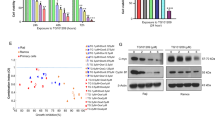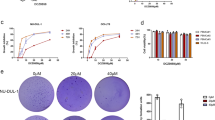Abstract
The mechanisms that regulate induction of the antiapoptotic state and mitogenic signals in primary effusion lymphoma (PEL) are not well known. In efforts to identify novel approaches to block the proliferation of PEL cells, we found that curcumin (diferuloylmethane), a natural compound isolated from the plant Curcuma Ionga, inhibits cell proliferation and induces apoptosis in a dose dependent manner in several PEL cell lines. Such effects of curcumin appear to result from suppression of the constitutively active STAT3 through inhibition of Janus kinase 1 (JAK1). Our data also demonstrate that curcumin induces loss of mitochondrial membrane potential with subsequent release of cytochrome c and activation of caspase-3, followed by polyadenosin-5′-diphosphate-ribose polymerase (PARP) cleavage. Altogether, our findings suggest a novel function for curcumin, acting as a suppressor of JAK-1 and STAT3 activation in PEL cells, leading to inhibition of proliferation and induction of caspase-dependent apoptosis. Therefore, curcumin may have a future therapeutic role in PEL and possibly other malignancies with constitutive activation of STAT3.
This is a preview of subscription content, access via your institution
Access options
Subscribe to this journal
Receive 50 print issues and online access
$259.00 per year
only $5.18 per issue
Buy this article
- Purchase on Springer Link
- Instant access to full article PDF
Prices may be subject to local taxes which are calculated during checkout







Similar content being viewed by others
References
Anto RJ, Mukhopadhyay A, Denning K and Aggarwal BB . (2002). Carcinogenesis, 23, 143–150.
Aoki Y, Feldman GM and Tosato G . (2003). Blood, 101, 1535–1542.
Aoki, Y, Yorchoan R, Braun J, Iwamoto A and Tosato G . (2000). Blood, 96, 1599–1601.
Barton BE, Murphy TF, Shu P and Huang HF . (2004). Mol. Cancer Ther., 3, 1183–1191.
Benekli M, Baer MR, Baumann H and Wetzler M . (2003). Blood, 101, 2940–2954.
Bharti AC, Donato N, Singh S and Aggarwal BB . (2003a). Blood, 101, 1053–1062.
Bharti AC, Donato N and Aggarwal BB . (2003b). J. Immunol., 171, 3863–3871.
Bharti AC, Shishodia S, Reuben JM, Weber D, Alexanian R, Raj-Vadhan S, Estrov Z, Talpaz M and Aggarwal BB . (2004). Blood, 103, 3175–3184.
Bromberg JF, Wrzeszczynska MH, Devgan G, Zhao Y, Pestell RG, Albanese C and Darnell Jr JE . (1999). Cell, 98, 295–303.
Buettner R, Mora LB and Jove R . (2002). Clin. Cancer Res., 8, 945–954.
Bush JA, Cheung Jr KJ and Li G . (2001). Exp. Cell Res., 271, 305–314.
Cannon ML and Cesarman E . (2004). Oncogene, 23, 514–523.
Chen H, Zhang ZS, Zhang YL and Zhou DY . (1999). Anticancer Res., 19, 3675–3680.
Cheong JW, Eom JI, Maeng HY, Lee ST, Hahn JS, Ko YW and Min YH . (2003). Leuk. Res., 27, 1159–1162.
Chuang SE, Kuo ML, Hsu CH, Chen CR, Lin JK, Lai GM, Hsieh CY and Cheng AL . (2000). Carcinogenesis, 21, 331–335.
Desagher S, Osen-Sand A, Nichols A, Eskes R, Montessuit S, Lauper S, Maundrell K, Antonsson B and Martinou JC . (1999). J. Cell Biol., 144, 891–901.
Deveraux QL and Reed JC . (1999). Genes Dev., 13, 239–252.
Deveraux QL, Roy N, Stennicke HR, Van Arsdale T, Zhou Q, Srinivasula SM, Alnemri ES, Salvesen GS and Reed JC . (1998). EMBO J., 17, 2215–2223.
Drexler HG, Uphoff CC, Gaidano G and Carbone A . (1998). Leukemia, 12, 1507–1517.
Guschin D, Rogers N, Briscoe J, Witthuhn B, Watling D, Horn F, Pellegrini S, Yasukawa K, Heinrich P and Stark GR . (1995). EMBO J., 14, 1421–1429.
Huang MT, Lou YR, Xie JG, Ma W, Lu YP, Yen P, Zhu BT, Newmark H and Ho CT . (1998). Carcinogenesis, 19, 1697–1700.
Jones KD, Aoki Y, Chang Y, Moore PS, Yarchoan R and Tosato G . (1997). Blood, 94, 2871–2879.
Kalechman Y, Gafter U, Weinstein T, Chagnac A, Freidkin I, Tobar A, Albeck M and Sredni B . (2004). J. Biol. Chem., 279, 24724–24732.
Kawamori T, Lubet R, Steele VE, Kelloff GJ, Kaskey RB, Rao CV and Reddy BS . (1999). Cancer Res., 59, 597–601.
Keller SA, Schattner EJ and Cesarman E . (2000). Blood, 96, 2537–2542.
Kim HY, Park EJ, Joe EH and Jou I . (2003). J. Immunol., 171, 6072–6079.
Klepfish A, Sarid R, Shtalrid M, Shvidel L, Berrebi A and Schattner A . (2001). Leuk. Lymphoma, 41, 439–443.
Li L, Aggarwal BB, Shishodia S, Abbruzzese J and Kurzrock R . (2004). Cancer, 101, 2351–2362.
Limtrakul P, Lipigorngoson S, Namwong O, Apisariyakul A and Dunn FW . (1997). Cancer Lett., 116, 197–203.
Lodha R and Bagga A . (2000). Ann. Acad. Med. Singapore, 29, 37–41.
Masood R, Zhang Y, Bond MW, Scadden DT, Moudgil T, Law RE, Kaplan MH, Jung B, Espina BM, Lunardi-Iskandar Y, Levin A and Jill PS . (1995). Blood, 85, 3423–3430.
Mukhopadhyay A, Bueso-Ramos C, Chatterjee D, Pantazis P and Aggarwal BB . (2001). Oncogene, 20, 7597–7609.
Nador PG, Cesarman E, Chadburn A, Dawson DB, Ansari MQ, Sald J and Knowles DM . (1996). Blood, 88, 645–656.
Prakash O, Tang ZY, Peng X, Coleman R, Gill J, Farr G and Samaniego F . (2002). J. Natl. Cancer Inst., 94, 926–935.
Pene F, Claessens YE, Muller O, Viguie F, Mayeux P, Dreyfus F, Lacombe C and Bouscary D . (2002). Oncogene, 21, 6587–6597.
Rodig SJ, Meraz MA, White JM, Lampe PA, Riley JK, Arthur CD, King KL, Sheehan KC, Yin L, Pennica D, Johnson Jr EM and Schreiber RD . (1998). Cell, 93, 373–383.
Sredni B, Weil M, Khomenok G, Lebenthal I, Teitz S, Mardor Y, Ram Z, Orenstein A, Kershenovich A, Michowiz S, Cohen YI, Rappaport ZH, Freidkin I, Albeck M, Longo DL and Kalechman Y . (2004). Cancer Res., 64, 1843–1852.
Syng-Ai C, Kumari AL and Khar A . (2004). Mol. Cancer Ther., 3, 1101–1108.
Tomlinson CC and Damania B . (2004). J. Virol., 78, 1918–1927.
Uddin S, Fish EN, Sher DA, Gardziola C, White MF and Platanias LC . (1997). J. Immunol., 158, 2390–2397.
Uddin S, Ah-Kang J, Ulaszek J, Mahmud D and Wickrema A . (2004a). Proc. Natl. Acad. Sci. USA, 101, 147–152.
Uddin S, Hussain A, Al-Hussein K, Platanias LC and Bhatia KG . (2004b). Biochem. Biophys. Res. Commun., 320, 932–938.
Uddin S, Hussain RA, Al-Husein KA, Manogaran PS, Wickrema A, Gutierrez MI and Bhatia KG . (2005). Clin. Cancer. Res., 11, 3102–3108.
Zhang C, Hazarika P, Ni X, Weidner DA and Duvic M . (2002). Clin. Cancer Res., 8, 1234–1240.
Author information
Authors and Affiliations
Corresponding authors
Rights and permissions
About this article
Cite this article
Uddin, S., Hussain, A., Manogaran, P. et al. Curcumin suppresses growth and induces apoptosis in primary effusion lymphoma. Oncogene 24, 7022–7030 (2005). https://doi.org/10.1038/sj.onc.1208864
Received:
Revised:
Accepted:
Published:
Issue Date:
DOI: https://doi.org/10.1038/sj.onc.1208864
Keywords
This article is cited by
-
Co-delivery of Doxorubicin and Curcumin with Polypeptide Nanocarrier for Synergistic Lymphoma Therapy
Scientific Reports (2020)
-
XIAP over-expression is an independent poor prognostic marker in Middle Eastern breast cancer and can be targeted to induce efficient apoptosis
BMC Cancer (2017)
-
Restoring PU.1 induces apoptosis and modulates viral transactivation via interferon-stimulated genes in primary effusion lymphoma
Oncogene (2017)
-
Bortezomib-mediated downregulation of S-phase kinase protein-2 (SKP2) causes apoptotic cell death in chronic myelogenous leukemia cells
Journal of Translational Medicine (2016)
-
Inhibition of Autophagy Enhances Curcumin United light irradiation-induced Oxidative Stress and Tumor Growth Suppression in Human Melanoma Cells
Scientific Reports (2016)



